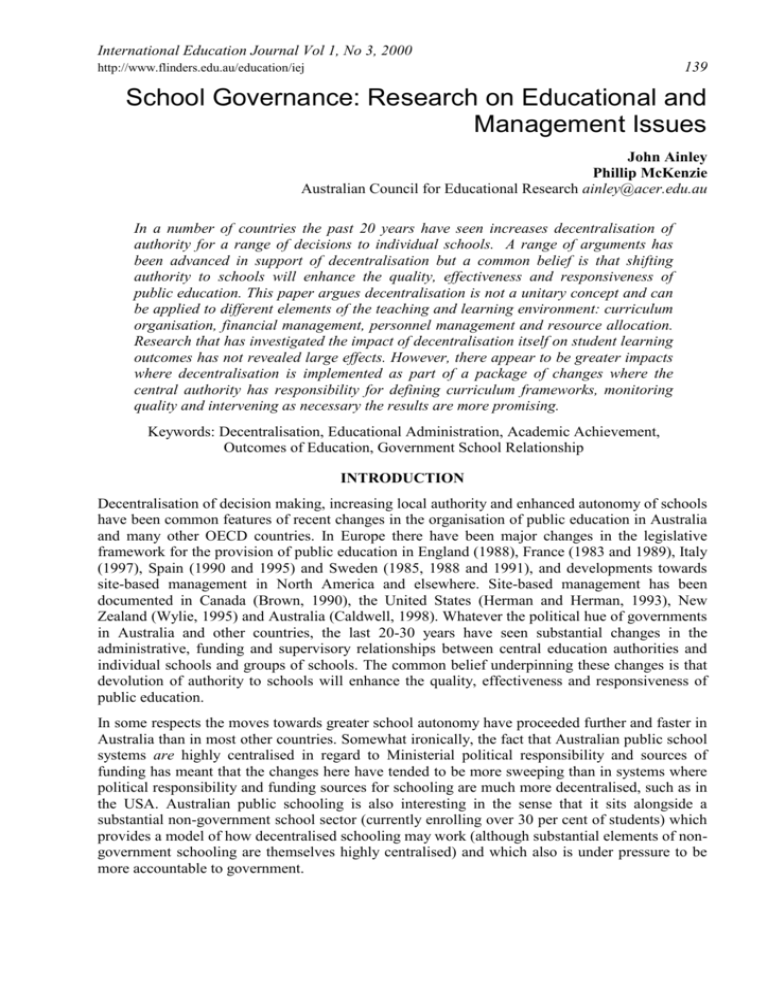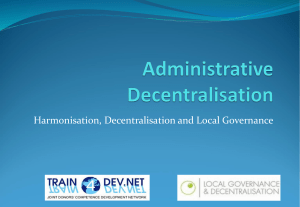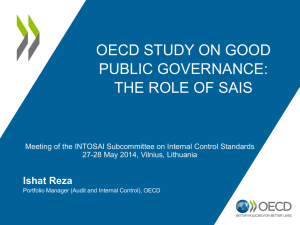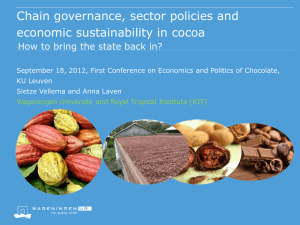dimensions of decentralisation
advertisement

International Education Journal Vol 1, No 3, 2000 139 http://www.flinders.edu.au/education/iej School Governance: Research on Educational and Management Issues John Ainley Phillip McKenzie Australian Council for Educational Research ainley@acer.edu.au In a number of countries the past 20 years have seen increases decentralisation of authority for a range of decisions to individual schools. A range of arguments has been advanced in support of decentralisation but a common belief is that shifting authority to schools will enhance the quality, effectiveness and responsiveness of public education. This paper argues decentralisation is not a unitary concept and can be applied to different elements of the teaching and learning environment: curriculum organisation, financial management, personnel management and resource allocation. Research that has investigated the impact of decentralisation itself on student learning outcomes has not revealed large effects. However, there appear to be greater impacts where decentralisation is implemented as part of a package of changes where the central authority has responsibility for defining curriculum frameworks, monitoring quality and intervening as necessary the results are more promising. Keywords: Decentralisation, Educational Administration, Academic Achievement, Outcomes of Education, Government School Relationship INTRODUCTION Decentralisation of decision making, increasing local authority and enhanced autonomy of schools have been common features of recent changes in the organisation of public education in Australia and many other OECD countries. In Europe there have been major changes in the legislative framework for the provision of public education in England (1988), France (1983 and 1989), Italy (1997), Spain (1990 and 1995) and Sweden (1985, 1988 and 1991), and developments towards site-based management in North America and elsewhere. Site-based management has been documented in Canada (Brown, 1990), the United States (Herman and Herman, 1993), New Zealand (Wylie, 1995) and Australia (Caldwell, 1998). Whatever the political hue of governments in Australia and other countries, the last 20-30 years have seen substantial changes in the administrative, funding and supervisory relationships between central education authorities and individual schools and groups of schools. The common belief underpinning these changes is that devolution of authority to schools will enhance the quality, effectiveness and responsiveness of public education. In some respects the moves towards greater school autonomy have proceeded further and faster in Australia than in most other countries. Somewhat ironically, the fact that Australian public school systems are highly centralised in regard to Ministerial political responsibility and sources of funding has meant that the changes here have tended to be more sweeping than in systems where political responsibility and funding sources for schooling are much more decentralised, such as in the USA. Australian public schooling is also interesting in the sense that it sits alongside a substantial non-government school sector (currently enrolling over 30 per cent of students) which provides a model of how decentralised schooling may work (although substantial elements of nongovernment schooling are themselves highly centralised) and which also is under pressure to be more accountable to government. 140 School Governance: Research on Educational and Management Issues As anyone who has lived through the last decade or two of Australian public schooling would know, however, “decentralisation” is far from a being a unidimensional and uncontested concept. For example, depending on the state concerned, at any one time schools could be simultaneously experiencing greater autonomy in financial and staffing matters, and less autonomy in curriculum development and student assessment. In Europe too, behind the overall similarity in the trends towards devolution there remain substantial differences in the areas of decision making transferred from the centre to the school: organisation of curriculum; financial management; personnel management; and resource allocation. In addition Bottani (2000) notes that an increase in decentralisation to school sites in some areas of management has been accompanied by an increase in control by the centre in areas such as curriculum (eg. through national curriculum frameworks). In this paper we will argue that is important for research on school governance to focus on the detail of decentralisation. To help understand and analyse the nature of decentralisation we use a framework based on a structure originally developed by the OECD. That framework is built around decision fields (organisation of instruction, planning and structures, personnel management and resource allocation), decision levels (national, state, intermediate and local) and decision modes. A framework such as this can help clarify deliberations about the appropriate levels of decision making for particular aspects of school governance. An awareness of the different dimensions of decentralisation can also aid interpretation of the somewhat contradictory research findings that have been reported from different settings on the relationship between “decentralisation” and educational outcomes. The presentation will argue that, for both educational research and practice, it is important to consider questions of school governance in relation to particular aspects of management rather than as a single dimension of decentralisation. DIMENSIONS OF DECENTRALISATION In their cross-national review of policy and research on decentralisation within public education systems, Walberg et al (2000) identified 22 different definitions of the term, including: principals collegially share power with teachers; restructuring government to satisfy citizen needs and interests; and school-based decision making. The framework developed by the OECD during the 1990s to guide its cross-national data collection and indicator development on the locus of decision-making authority in education systems provides a comprehensive means of capturing the various meanings attributed to decentralisation. The framework comprises six levels of decision (two levels were added in the late 1990s to the original four used in the early 1990s in order to better express relationships in federal and regional systems), four fields of decision, and three modes of decision. Each of these groupings in turn comprises a number of different sub-levels or elements. The framework is shown in Table 1. The analysis by Walberg et al (2000) indicated that the 22 definitions of decentralisation they identified in various national research studies could all be encompassed within the OECD framework, which underlines its usefulness. Nevertheless, to apply the framework within countries like Australia some further disaggregation and elaboration could well be required to more fully capture the diversity of local circumstances. For example, in the dimension concerned with Levels of Decision it could be important to distinguish within the School level between formal levels of responsibility that may lay with the principal or School Council and actual location of decision making by senior teachers or groups of teachers. Similarly, the framework does not quite capture the situation that has been common in most Australian states whereby regional sub-units of central education departments exercise considerable authority over resource Ainley and McKenzie 141 allocation but the regional offices do not really constitute territorial authorities or levels of government. 142 School Governance: Research on Educational and Management Issues Table 1. Dimensions of the OECD Surveys on Loci of Decision Making Levels of decision Fields of decision Modes of decision School, School Board or Committee: school administrators and teachers or a school board or committee established exclusively for the individual school. Organisation of Instruction: bodies determining school attendance, student promotion and transfer, instruction time, choice of textbooks, criteria for grouping students, additional support for students with learning difficulties, teaching methods, assessments of students’ regular work Full Autonomy: subject only to constraints contained in the constitution or in legislation outside the education system itself Local Authorities or Governments: the municipality or community that is the smallest territorial unit in the nation with a governing authority. Sub-regional or Inter-municipal Authorities or Governments: the second territorial unit below the nation in countries that do not have a federal or similar type of governmental structure Provincial or Regional Authorities or Governments: the first territorial unit below the national level in countries that do not have a federal type of governmental structure; and the second territorial unit below the nation in countries that have a federal or similar type of governmental structure State Governments: The first territorial unit below the nation in federal countries Personnel Management: (principals, teachers, nonteaching posts): hiring and dismissal, duties and conditions of service, fixing of salary scales, influence over the careers of staff In Conjunction or After Consultation: with bodies located at another level in the education system Independently but Within a Framework Set by a Higher Authority: eg a binding law, a pre-established list of possibilities, or a budgetary limit Planning and Structures: creation or closure of school, determining programs of study for a particular type of school, definition of course content, setting of qualifying examinations for a certificate or diploma Resources: (for teaching staff, non-teaching staff, other current expenditures, capital expenditure): allocation of resources to the school, use of resources in the school Central Government: all bodies at national level that make decisions or participate in different aspects of decision making Sources: OECD (1995); OECD (1998); Bottani (2000) It is interesting to note, too, that the OECD framework makes no explicit mention of decision making by parents for example, as to where they enrol their children. In the case of Australia it could be argued that the removal of zoning restrictions on where parents enrol their children has been a powerful force towards greater school accountability and responsiveness over and above any other changes in the pattern of school governance. This is particularly so in a climate of generally declining school enrolments and increased competition among schools. Nevertheless, the OECD framework is a useful mapping of the broad dimensions of the concept of school governance and the care needed in examining the detail of what is meant by decentralisation. Ainley and McKenzie 143 CHARACTERISING SCHOOL GOVERNANCE IN AUSTRALIA Sturman (1989) provides a useful analysis of the major changes in the focus of decentralisation in Australian government school systems in the decades of the 1960s, the 1970s and the 1980s. Simplifying his analysis somewhat, he argued that the 1960s were associated with structural pressures for change (government systems were growing very rapidly and becoming hard to manage from the centre) and changes in attitudes and values that supported greater teacher and student involvement in decision making. These pressures were also evident in the 1970s and during that time they were overlain with a stronger interest in redressing educational disadvantage and the benefits of local responses in addressing individual learning needs, as well as pressures to update existing curricula and to develop new curriculum areas. The 1980s were characterised by Sturman as a time for accountability, with the adjectives “rigorous”, “consistent” and “coordinated” replacing the earlier emphases on “flexibility”, “adaptation” and “participation”. The 1980s were a time of major reviews in most government school systems that attempted to develop stronger curriculum frameworks that to some extent moved the responsibility for curriculum development back from individual schools and teachers to central authorities. Towards the end of the 1980s the first of the state-wide assessment programs also started to appear, presumably partly in response to the demise of the inspectorate in most systems during the 1970s and early 1980s. The processes of centralised curriculum control and tighter lines of accountability have continued into the 1990s, but with some interesting countervailing developments. First, in government school systems like Victoria significant responsibility for personnel matters (eg selection of principals) and operating budgets (initially responsibility for non-teacher expenditures, but now full global budgets) have been devolved to school councils and principals. Second, school accountability is now expected to be demonstrated outwards to parents and the local community as well as upwards to the centre. Third, considerable effort has been put into better equipping schools with the management tools and data to better exercise their responsibilities. Fourth, the 1990s have seen significant progress towards a more national approach to schooling as reflected in national qualifications frameworks, recognition of teachers’ qualifications across state borders, and equating of tertiary entrance scores. In terms of the OECD framework used in Table 1 the period from the 1960s to the 1990s can be characterised as one in which State Governments changed from having virtually full autonomy over the four major fields of decision making about schooling, and schools and the national government had virtually none, to one in which the State Government, schools and national government to some extent operate in conjunction or collaboration in all four fields with the extent of decentralisation to schools varying according to particular elements within the broad fields. The most recent data reported by the OECD on how the distribution of decision-making authority in Australian schools compared to that in other countries was derived from the 1995 Third International Mathematics and Science Study (TIMSS) conducted by the IEA. The data reported the perceptions of principals of schools enrolling 8th-grade students about where primary responsibility lay for a number of curriculum and school organisation decisions. Data were reported for 21 OECD countries (OECD, 2000). A distinctive aspect of the perceptions reported by Australian school principals was the relatively high prominence given to decision making exercised being exercised primarily by Department Heads in the school. In the area of curricular organisation Australia was second only to New Zealand in the high proportion of principals reporting that Department Heads in the school had primary responsibility for “choosing textbooks” (88%) and determining course content (76%). In 144 School Governance: Research on Educational and Management Issues most other countries Teachers were identified by school principals as having primary responsibility in these regards, which raises the interesting possibility than Australian schools may exhibit comparatively high levels of internal curriculum coherence In regard to school organisation the Australian principals reported that Department Heads had primary responsibility for student grading policies (61%), placing students in classes (85%) and establishing homework policies (51%). In the latter instances in most other countries the primary responsibility was reported to be exercised by either the Principal or Teachers. These data reinforce the need for any schema of decentralisation to enable identification of different loci of decision-making responsibility within schools as well as between schools and other authorities. IMPLEMENTING SITE-BASED MANAGAMENT Leithwood and Menzies (1998) review the literature concerned with the implementation of sitebased management. They note other purposes for school-based management; to provide more direct forms of accountability, to provide greater discretion in the use of resources and to make more use of the professional capacities of staff. In addition they identify three forms of decentralisation or school-based management depending on where the locus of decision making lies. Administrative school-based management is aimed at is concerned with delegation of authority from the central office to the principal and is focussed on increased efficiency in the use of resources and on accountability through the principal. Professional control school-based management focuses on the role of teachers and decision-making structures within schools with the goal of increasing the efficacy of professional staff in schools. Community site-based management is concerned with accountability to parents and the community at large and often is associated with a curriculum that is thought to reflect more directly the values and preferences of parents. Leithwood and Menzies note the mixture of models in most administrative changes but emphasise that the differences in modes of decentralisation can have different expectations regarding outcomes. They observe that professional-control site-based management may have the greatest potential to impact on student learning. Leithwood and Menzies (1998) argue that the potential for site-based management to impact on student learning is often blunted by problems of implementation. They analysed nearly 80 empirical and case studies of the implementation of site based management between 1985 and 1995. Overall they observe that whatever forms of site-based management were intended the result was often a variant of administrative control mode. This they argue is because the other modes of site-based management required internal change in schools and that this was not planned for and involved significant costs in terms of the time of principals and teachers. The largest category of obstacles identified in the review concerned attitudes and beliefs. This includes concerns about the viability of the new approach and consequences for ones individual approach to work. Lack of knowledge, skills and behaviours (in terms of the requisites to implement new forms of management) was a frequent obstacle as was lack of opportunities (time and resources). Leithwood and Menzies note that these groups of obstacles are commonly mentioned in the broader literature on the implementation of change. Practitioners become overwhelmed at needing to maintain and change their organisations concurrently. In Australia, Sturman (1989) notes that the impact of the devolution of curriculum decision making in Australia had limited impact for a number of structural reasons and because the beliefs of teachers about the nature of knowledge were strongly established. In general the conclusion from the analysis conducted by Leithwood and Menzies (1998) is that decentralisation to schools may have only limited impact on what happens in schools unless specific attention is paid to implementing within school change. They argue that the most Ainley and McKenzie 145 promising ventures in this direction model the within-school processes on the lines of highinvolvement organisations. EVIDENCE ON LINKS BETWEEN SCHOOL AUTONOMY AND OUTCOMES Studies of School Effects Many studies in education from the mid-1960s to the mid-1970s concluded that differences among schools had little real impact on student outcomes. For example the report on equality of educational opportunity in the United States concluded that schools bring little influence to bear on a child’s achievement that is independent of the child’s background and general social context (Coleman et al, 1966, p. 325). Other scholars reached similar conclusions. These conclusions about the effectiveness of schools were based on large-scale sociological inquiries with various units (often aggregated) of analysis and focussed on questions of equality of opportunity for various social groups. The studies often had fairly weak measures of school factors. Even though there were contrary interpretations of the same data which stressed that schools might indeed have an effect on student outcomes (Madaus et al, 1980), the overall the story was a pessimistic one. In the late 1970s and early 1980s there emerged a body of research concerned with effective schools. It originated in a concern with equity; an intention to improve the achievement outcomes of students in schools located in poor inner-urban areas. These studies focussed attention on achievement test scores in literacy and numeracy as indicators of school effectiveness. Many of those early studies sought to identify schools which were “unusually” effective in terms of achievement in reading and mathematics and then to probe the sources of effectiveness, using case study methods and systematic comparisons (Teddlie, Kirby and Stringfield, 1989). In recent times investigations of the effectiveness of schools have been based on studying the differences in student outcomes among schools. Where outcomes differ among schools, after allowing for different background characteristics of the students attending those schools and aspects of school context, it is taken as evidence that schools have contributed to those outcomes. One of the more important conclusions to emerge from recent research, and major reviews of research, on school effectiveness is that some schools are more effective than others (McGaw, Piper, Banks and Evans, 1992; Scheerens and Bosker, 1997; Teddlie and Reynolds, 2000). In other words differences among schools appear to be systematically associated with differences in student outcomes. That research has suggested that the differences among schools might be as substantial as differences in social background in shaping some important outcomes of schooling. There is now an emerging consensus that between eight and 15 per cent of the variance in achievement outcomes is associated with the school attended (Bosker and Scheerens, 1997). School Governance as an Element in School Effects The recently published International Handbook of School Effectiveness Research (Teddlie and Reynolds, 2000) notes that school governance structures have been studied as context variables in school effectiveness (eg. private versus public, different types of church schools, different districts and school boards). Teddlie and Reynolds (2000: 184-185) conclude from this literature that the size of school effects “tend to be larger in schools that have governance structures allowing more control of their academic operations”. In other words, and not surprisingly, there is more variation among schools in devolved than among schools in centralised systems. However, in terms of the overall effect of school governance on student outcomes the research evidence is not extensive. A meta-analysis of school-based management in the United States in the 1980s revealed little impact (Malen, Ogawa and Kranz, 1990). Summers and Johnson (1998) point to the problems that arise from the many meanings attached to terms such as site-based management and the limited number 146 School Governance: Research on Educational and Management Issues of studies that include a measure of student outcomes as well as measures of the extent of devolution of authority. More recently Walberg, Paik, Komukai and Freeman (2000) have drawn together results from a number of studies of decentralisation from a number of different countries. That review points to the range of different definitions of decentralisation and related views of its effectiveness. The authors conclude that despite the amount of policy interest in decentralisation its features have little influence on value-added learning. The review argues that classrooms and schools have more consistent effects on learning than how decision making is divided among levels of government. In fact they suggest that decision making by intermediate units is less effective than central control. Despite this picture of the effects of governance there remain important questions of articulation. In other words how does the pattern of governance of schools influence the all-important conditions in classrooms and schools? Grissmer, Flanagan, Kawata and Williamson (2000) analyse factors associated with improved scores on the National Assessment of Educational Progress in the United States. Those analyses point to improvements that link to policy changes and argue that the substantial improvements in North Carolina and Texas have resulted from “an integrated set of policies involving standards assessment and accountability”. Elsewhere the report identifies changes in school governance as a policy development but does not explicitly link those policies to the gains. There is a number of problems in research on the effects of school governance. One is the lack of variation within systems of schools (schools within a system tend to have the same patterns of governance). A second is the confounding effects of other influences when comparisons are made between school systems (eg. in student background when comparing public and private schools). A third is that when changes are introduced in a school system other changes are made at the same time (eg. new quality assurance systems at the same time as devolved governance). These and other issues make the field a challenging one in which inferences are likely to be conditional and contested rather than clear and ambiguous. There are three main sources of research evidence that might inform deliberations about the effects of governance on outcomes: studies of changes that have been introduced in education systems, studies of differences between school systems within country contexts and studies of differences between corresponding types of school in different countries. The Effects of Changes Introduced to School Systems The Chicago School Reforms Studies of changes in the governance of schools in the Chicago School District have been extensively researched with the results of that research being used to inform the progress of the changes that had been introduced. The first phase of the Chicago school reforms in 1988 involved decentralisation of authority to school sites. The second phase involved strengthening authority for accountability at district level while retaining devolved authority for operations in a Local School Council. Wong (2000) refers to this as an “integrated governance” which creates the appropriate balance of pressure and support to sustain improved outcomes. A longitudinal study of students progressing through school during the first phase of the reform indicated generally improved outcomes in elementary schools but mixed results across subject areas and cohorts (Bryk et al, 1998). Wong (2000) argues that that the stronger and more consistent improvement emerged in the second phase of the reforms when the district asserted a stronger role in monitoring, accountability and intervention. Ainley and McKenzie 147 Philadelphia Changes in school governance in Philadelphia introduced during the 1990s involved decentralisation of decision-making (based around School Councils) but within a new curriculum framework and a program of monitoring outcomes in reading mathematics and science at several year levels. Phillips (1997) reports improvements in test scores in those areas but it is not clear whether the improvement resulted from the decentralisation or the monitoring program that was linked to a range of interventions in schools. Britain Since 1988 in Britain there has been an initiative towards locally managed schools and it has been possible for schools in Britain to operate independently of local authorities (as grant-maintained schools). There are conflicting claims regarding the outcomes from grant-maintained schools. Levacic and Hardman (1999) showed that grant-maintained schools had shown a higher level of improvement (in GCSE results) over a five-year period than locally managed schools but this was explained by their changing composition. When changes in composition of the student body was taken into account there was no difference in the levels of achievement of the schools. Charter Schools in the United States of America Gannicott (1998) outlines the growth in numbers of charter schools in the United States over the past five years. Charter schools are publicly funded but autonomously managed under a contract or charter. He notes that there is little systematic evidence of outcomes regarding charter schools despite a range of anecdotal comment and indications from individual schools (Finn et al, 1997). Favourable results in mathematics and reading have been reported for the Milwaukee Parental Choice Program in terms of school choice but only after three or four years in the program (Gannicott, 1998). In this exercise there was roughly random admission to the program for those seeking admission and there were statistical controls for the effects of family background and context. Schools of the Future in Victoria The Schools of the Future in Victoria involved a high level of self-management by schools within a newly articulated curriculum and standards framework and a program of quality assurance through school annual reports. As part of a formative evaluation study Principals in those schools responded to a questionnaire on which they expressed an opinion about the extent to which objectives of the program were being achieved (Caldwell, 1998). Analysis of those data suggest a number of associations with curriculum and learning benefits but it is not possible from these data to ascertain whether their have been measurable improvements in achievement. Differences between School Systems within National Contexts Some of the support for the view that outcomes are enhanced in a decentralised system of school management is drawn from considerations of differences between school systems. Public and Private Schools in the United States Gannicott (1998) discusses the analyses conducted by Chubb and Moe (1990) of achievement gains over the final two years of high school. The analysis utilised a composite index of student achievement in reading, writing, mathematics and science. Since initial student achievement was incorporated in the analysis the influences that were identified were influences on achievement gain. On the basis of those analysis (which included individual socioeconomic background and 148 School Governance: Research on Educational and Management Issues school socioeconomic status) the authors concluded that school organisation (a measure of autonomy) had an impact on achievement gain over the two years. The measure of school organisation is closely related to school system differences. Chubb and Moe (1990) argue that the reason why private schools appear to be more effective than public schools is because of their organisational characteristics (that are linked to their autonomy). However, one should pause to consider that there may be other differences between the school sectors that impact on outcomes that have not been included in the analysis: motivation and parental expectations for example. Gannicott (1998) also refers to a succession of studies of Catholic schools in the United States. There has been a succession of studies over many years of Catholic schools compared to public schools (Hoffer, Greeley and Coleman, 1985). Some studies examined the effects of Catholic and public schools using data from the High School and Beyond collection (Coleman, Hoffer and Kilgore, 1982; Coleman and Hoffer, 1987). The findings have reported higher achievement in Catholic schools in reading, mathematics and science overall and especially for minority students. In addition Catholic schools had lower rates of leaving school before the final year (Evans and Schwab, 1995). Subsequent studies using different techniques have argued that there was no significant difference between the school systems for white students but confirmed the advantage for minority students. These results have been often been interpreted as reflecting the effectiveness of a decentralised form of administration. However, other interpretations that may be linked to school organisation have also been suggested. Hoffer et al (1985) suggest that higher achievement results from placing students in academic rather than vocational programs (see also Lee, Bryk and Smith, 1993), providing more time in academic courses and assigning more homework. Rowan, Raudenbush and Kang (1991) suggest that Catholic schools appear to have more supportive administrative leadership, participative decision making and higher levels of staff co-operation. Lee et al (1993) interpret the differences in organisation between Catholic and public schools as reflecting a shared sense of purpose or community. It is possible that Catholic schools are more able to develop a unified sense of purpose because they are less subject to bureaucratic regulation and multiple goals or it may be that these features derive from other sources. Other Studies of School Systems Scheerens and Bosker (1997: 278) conclude a review of studies of public and private school systems in a number of countries with the observation that in developed countries, private schools appear to be more effective, even in where both are financed by the state. They attribute this to the roles of parents in private schools as more active consumers of educational provision. McPherson and Willms (1986) found that achievement scores (after controlling for student intake characteristics) from Catholic secondary schools in Scotland were somewhat higher than those from non-denominational schools,. A study conducted in the Netherlands investigated the effects of different schools on participation in higher education and in the labour market (Van CuyckRemijssen and Dronkers, 1990). Although there were differences associated with school systems on entry to university those differences favoured public schools and there were no differences in university success or in the labour market. Toma (1996) reports an examination of mathematics achievement from the Second International Mathematics Study conducted in 1981. Because testing was conducted at the beginning and the end of the year it was possible to use a value-added model as well as make allowance for a range of student background characteristics. The model was used to estimate the differences in growth over one year for public and private schools in each country. The differences in gains between school systems in each of the countries vary somewhat. Toma argues that this reflects the degree of autonomy of private schools in those countries but it is possible that there are other differences in national contexts. Such results highlight the importance of differences in national contexts in interpreting school system effects. Ainley and McKenzie 149 Australian Studies There is little information from Australian studies that employ adequate controls for differences in intake characteristics. Analyses of the Social Science Survey suggested that, after controlling for other factors, private school students were more likely to complete secondary school and graduate from university (Kelley and Evans, 1999). Of course one might interpolate that this reflects one of the key unmeasured background influences: motivation and aspirations. Using the same data to focus on Catholic schools suggested that there was an educational advantage of attending a Catholic school compared to a government school after controlling for the effects of background (Graetz, 1990). Long Carpenter and Hayden (1999) conclude that the effect of attending a private school on school completion decreased from the 1980s to the 1990s but the effect on university participation remained evident. Cross-National Comparisons Given that there are differences between countries in the management of the public school sector that more use has not been made of international data sets such as those from the IEA studies that would allow achievement to be related to organisational arrangements for schools in comparable sectors. Schmidt and Prawat (1999) made use of data from the Third International Mathematics and Science Study to examine where decisions are made within different education systems. The purpose of the study was to seek information about those issues that were decided locally and those that were determined centrally. Across the education systems represented in that study they reported a uniformly high level of central control of both goals and the content of instruction with only methods of instruction and selection of materials being locally determined. The analysis reported by Schmidt and Prawat indicate that local control of important curricular decisions is not common in many countries and comparisons between countries does not provide guidance about the appropriate mixture of central and local authority in educational governance. Moreover the study does not relate patterns of governance to outcomes. Scheerens and Bosker (1997: 279) conclude that there is no evidence that national systems where there is more autonomy for schools perform better in the area of basic competencies. In the Third International Mathematics and Science Study it was the more centralised education systems that performed relatively better. Although there is potential in international studies of achievement to examine the influences of school governance in the public schools that potential has not been used extensively. One of the problems is that such data usually incorporate only assessments at one point in time so that achievement growth cannot be assessed and used as the measure of student learning. Another is that there is a range of contextual information that needs to be included, as part of the analysis is wider than is typically collected or analysed. Notwithstanding those difficulties cross-national comparisons of public schools may provide a useful perspective on the impact of governance modes on student outcomes. Of course there is a set of questions to be considered regarding the effects of patterns of school governance on the social distribution of educational outcomes to be considered in addition to effects on levels of outcomes. Whitty, Power and Halpin (1998) in a study of changing policies and practice in school governance in five countries conclude that there is evidence of wider disparities in educational opportunities in decentralised modes of governance but little evidence of general improvements in achivement. Analysis of data from international achievement studies would provide opportunities to test the effect of decentralisation on the distribution of educational outcomes. 150 School Governance: Research on Educational and Management Issues CONCLUSION Research on school governance is concerned with more than where decisions are made. It is concerned with the package of arrangements that constitute the framework within which teaching and learning occurs. Elements of that framework include the way the curriculum is organised, financial management, personnel management and resource allocation. In an early part of these paper it was noted that decentralisation could occur with respect to any or all of these elements. Research that has linked decentralisation by itself to student learning outcomes has not suggested large effects. However, decentralisation is often implemented as part of a package of changes. Where this package forms part of an integrated governance structure in which the central authority has responsibility for defining curriculum, monitoring quality and intervening as necessary the results are more promising. REFERENCES Bottani, N. (2000). Autonomy and decentralisation: between hopes and illusions. A comparative study of reforms in five European countries. Paper presented at the Annual Meeting of the AERA, New Orleans. Brown, N. (1990). Decentralisation and School Based Management. Bristol, Falmer. Bryk, A. (1998). Chicago school reform: Linkages between local control, educational supports and student achievement. Paper presented at the Annual Meeting of the American Educational Research Association, San Diego. Caldwell, B. (1998). Self-managing Schools and Improved Learning Outcomes. Canberra, DETYA. Chubb, J. and Moe, T. (1990). Politics, Markets and America’s Schools. Brookings Institute, Washington. Coleman, J. and Hoffer, T. (1987). Public and Private Schools: The Impact of Communities. New York, Basic Books. Coleman, J., Campbell, E., Hobson, C., McPartland, J., Mood, A., Weinfeld, F and York, R (1966) Equality of Educational Opportunity. Washington, DC, US Department Health, Education and Welfare. Coleman, J., Hoffer, T and Kilgore, S. (1982). High School Achievement: Public Catholic and Private Schools Compared. New York, Basic Books. Evans, W. and Schwab, R (1995). Finishing high school and starting: Do Catholic schools make a difference? Quarterly Journal of Economics, November. Finn, C., Vanourek, G., Manno, B. and Bierlen, L (1997). Charter Schools in Action, Final Report. [Online] http://www.edexcellence.net/chart/chart5.html [2000, August] Gannicott, K. (1998). School Autonomy and Academic Performance. Canberra, DETYA. Graetz, B. (1990). Private schools and educational attainment: cohort and generational effects. Australian Journal of Education, 34 (2). Grissmer, D., Flanagan, A., Kawata, J. and Williamson, S. (2000). Improving Student Achievement: What NAEP State Test Scores Tell Us. Santa Monica, Rand Corporation. [Online] http://www.rand.org [2000, August] Ainley and McKenzie 151 Herman, J and herman, J. (1993). School-based Management: Current Thinking and Practice. Springfield, Thomas. Hoffer, T., Greeley, A. and Coleman, J. (1985). Achievement growth in public and Catholic high schools. Sociology of Education, 58 (1). Hofman, R. (1995). Contextual influences on school effectiveness: the role of school boards. School Effectiveness and School Improvement, 6 (2), 308-331. Kelley, J. and Evans, M. (1999) Non-Catholic private schools and educational success. Australian Social Monitor, 2, 1-4. Lee, V., Bryk, A. and Smith, J. (1993) Organisation of effective secondary schools, in: L. DarlingHammond (Ed.) Review of Research in Education, 19, pp. 171-267. Leithwood, K. and Menzies, T. (1998). A review of research concerning the implementation of site-based management. School Effectiveness and School Improvement, 9 (3), 233-285. Levacic, R. and Hardman, J. (1999). The performance of grant maintained schools in England: an experiment in autonomy. Journal of Educational Policy, 14 (1), 185-212. Long, M., Carpenter, P. and Hayden, M. (1999) Participation in Education: 1980-1994. Melbourne, ACER. Madaus, G., Airasan, P., and Kellaghan, T. (1980) School Effectiveness: A Reassessment of the Evidence. New York, NY, Free Press. Madaus, G., Airasan, P., and Kellaghan, T. (1980) School Effectiveness: A Reassessment of the Evidence. New York, NY, Free Press. Malen, B., Ogawa, R. and Kranz, J. (1990). What do we know about site-based management: a case study of the literature. InW. Clune and J. Witte (Eds) Choice and Control in American Education Volume 2: The Practice of Choice and School Restructuring. London, Falmer. McGaw, B., Piper, K., Banks, D., and Evans, B. (1992) Making Schools More Effective. Melbourne, ACER. McPherson, A. and Willms, J. D. (1986). Certification, class conflict, religion and community: an explanation of the effectiveness of contemporary schools, in A. Kerkchoff (ed) Research in Sociology of Education and Socialisation, 6, 227-302. OECD (1995). Decision Making in 14 OECD Education Systems. Paris: OECD. OECD (1998). Education at a Glance. OECD Indicators 1998. Paris:OECD. OECD (2000). Education at a Glance. OECD Indicators 2000. Paris:OECD. Phillips, V. (1997) The role of accountability in student achievement. Paper presented to a seminar at Melbourne University. Rowan, B. Raudenbush, S. and Kang, S. (1991). Organisational design in high schools: a multilevel analysis. American Journal of Education, 99, 238-266. Scheerens, J. and Bosker, R. (1997). The Foundations of Educational Effectiveness. London, Pergamon. 152 School Governance: Research on Educational and Management Issues Schmidt, W. and Prawat, R. (1999). What does the Third International Mathematics and Science Study tell us about where to draw the line in the top-down versus bottom-up debate? Educational Evaluation and Policy Analysis, 21 (1), 85-91. Sturman, A. (1989). Decentralisation and the Curriculum: Effects of the Decentralisation of Curriculum Decision Making in Australia. ACER Research Monograph No. 35. Melbourne: ACER. Summers, A. and Johnson, A. (1996). The effects of school-based management plans. In E. Hanushek and D. Jorgenson (Eds) Improving America’s Schools: The Role of Incentives. Washington, National Academy Press, pp 75-96. Teddlie, C. and Reynolds, D. (2000). The International Handbook of School Effectiveness Research. London, Falmer. Teddlie, C. Kirby, P. and Stringfield, S. (1989) Effective versus ineffective schools: Observable differences in the classroom. American Journal of Education, 97, pp. 221-236. Toma, E. (1996) Public funding and private schooling across countries. Journal of Law and Economics, 39 (1). Van Cuyck-Rejmissen, A. and Donkers, J (1990). Catholic and Protestant schools, a better choice in the Netherlands? School Effectiveness and School Improvement, 1 (3), 211-220. Walberg, H., Paik, S., Komukai, A. and Freeman, K. (2000). Decentralization: An international perspective. Paper presented at the Annual Meeting of the AERA, New Orleans. Whitty, G., Power, S. and Halpin, D. (1998) Devolution and Choice in Education: The School, the State and the Market. Melbourne: Australian Council for Educational Research. Wong, K. (2000). Chicago school reform: From decentralisation to integrated governance. Journal of Educational Change, 1 (1), 97-105. Wylie, C. (1995). Site-based management: Some lessons from New Zealand. Paper presented at the annual meeting of the AERA, San Francisco. IEJ







